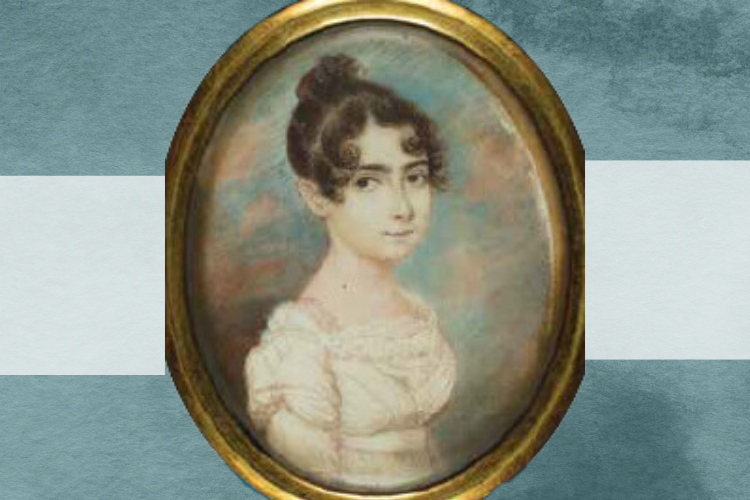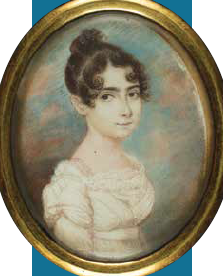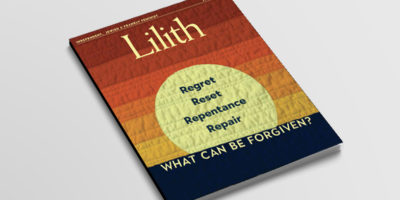
An Early American Portrait Yields Surprises About Race
Naomi Danis talks with historian Laura Arnold Leibman.

1815–16. Watercolor on ivory.
You’re a historian studying material culture. How does this work connect to what you call “restoring women’s agency as creators of Jewish identity”?
I came to the field of early Jewish American culture in a very roundabout way. Although I have always been an early Americanist, I began my career in Native American Studies and literature. I found myself turning more and more to material objects as a way talking about how people write without words. I found this approach to be particularly important for understanding indigenous communities who have precontact non-alphabetic literature, but also for writing a history of women who were denied access to certain kinds of education or whose words had been deemed “unimportant.”
Alice Walker speaks about this power that objects have in In Search of Our Mothers’ Gardens, when she recalls looking at an African American quilt hanging in the Smithsonian made by “an anonymous Black woman in Alabama, a hundred years ago.” For her, quilts and gardens became a place to identify what she calls “that muzzled and mutilated, but vibrant, creative, spirit” of women whose voices have been silenced. Restoring women’s agency means recognizing not only the forces that kept them silent, but also their creativity and the power of their imaginations. The way they created culture.
Sometimes recognizing how voices were left out can help us expand our vision and hear what was lost. Within Jewish studies, for example, “Judaica” has often been about ritual objects which, at least between 1750 and 1850, tended to be used by men. In The Art of the Jewish Family (Published by Bard Graduate Center, distributed by University of Chicago Press) I am interested in a different kind of Judaica: namely, objects that women used to create Jewish identities and to pass those traditions along to their children and grandchildren. It’s more teacups than Kiddush cups.
When I am looking for a history to tell, I almost always start with the object. Just like when Alice Walker visited the Smithsonian, I want objects that make me pause and say WOW. Like the quilt Walker describes, the objects I talk about are rare, “beyond price,” but also convey some deep feeling. The rareness isn’t about expensive materials (though some are made of precious things). The rareness is a glimpse into a life long lost, a life full of things history had forgotten to tell us about.
How did you find the ivory miniature of a woman born into slavery in the late eighteenth century in Barbados who became prominent in New York Jewish society? And how did you know whose portrait it was?
The ivory miniature I talk about in The Art of the Jewish Family has been a part of the collection at American Jewish Historical Society since the early twentieth century. The sitter is Sarah Brandon Moses (1798–1828), who was born in Barbados and died in New York. At the time of her death, Sarah had given birth to 10 children and was married to Joshua Moses, an Ashkenazi man from a prominent Jewish family. All this was public record.
What we didn’t know before I started researching the family is that Sarah had been born enslaved. Her father was one of the wealthiest Jews in Barbados, and in addition to securing Sarah’s freedom from the family that owned her, he helped her get a superb education at an elite Jewish boarding school in London and gave her a £10,000 dowry. Although Sarah’s early life as a slave wasn’t a secret during her own lifetime, by the time her granddaughter Blanche donated the miniature, Sarah’s origins had been forgotten.
I actually stumbled upon Sarah and her story because of work I had done on Sarah’s older brother, Isaac Lopez Brandon. Karl Watson, a Barbadian historian, had noticed that the records for the island’s synagogue mentioned during a dispute about voting rights that Isaac was the natural son of Abraham Rodrigues Brandon, and that Isaac was a “man of colour,” and “Jew from inclination” who had converted in Suriname. It was fairly easy to show that Isaac Lopez Brandon was the same as the man as in the portrait at AJHS (Isaac later moved to New York and married Joshua Moses’s sister). But it took many, many years to prove that the sister who was in the ivory miniature was the same sister that was manumitted with him in Barbados back in 1801. The miniature was inherited by Sarah’s granddaughter, Blanche Moses. It was one of several miniatures Blanche donated to the archive, including a companion portrait of Sarah’s brother Isaac. Fortunately for us, the Moses family kept good records of who was depicted in each portrait.
In your book, you use the concept of “racecraft,” developed by Black historians Karen and Barbara Fields, to talk about race as an assigned cultural status rather than a biological fact. How does this concept inform your understanding of the intersectional identities of Jews of color today?
I find the idea of racecraft helpful on so many levels. Racecraft is a way of breaking down structural racism and thinking about how structures get reinforced. Fields and Fields argue that race isn’t assigned arbitrarily, but through social practices, particularly sumptuary laws, rituals of deference and dominance, kinship, and the gaze. In the era I study, the notion of racecraft can help us think about how both non-Jews and Jewish communities marked Jews of color, and in doing so suggested that they were not “full” Jews. One way that this happened was by dividing communities into yachidim (European, full members) and congreganten (mixed-race or second-class Jews). Another way was marking certain people’s ketubot (marriage contracts) with the phrase “emancipated Jews,” which slyly referenced their African ancestry. Neither of these strategies have any basis in halacha (Jewish law). In today’s language, we would probably talk about this in terms of inclusion and see this as a fail.
While I don’t know of any Jewish American communities that have these practices today, racecraft can help us think about how we still fail some of the time at being inclusive. Expectations about dress, about who has authority in a community, who needs always to be friendly and smile, DNA, and who “looks” Jewish (and who decides what Jews look like!) all insinuate ideas about who is a “full” Jew. In my mind, the point here is not to pretend that we don’t see cultural differences among Jews, but to remember all Jews are part of subcultures. The ability to have your own subculture be unmarked is itself the work of racecraft. Bringing this back to the idea of intersectionality, the recent uprisings across the United States have brought this problem to the fore, at least where I live in Portland, Oregon. Each of us stands at the intersection of various identities, whether we are a Jew of color or not. Being inclusive doesn’t mean asking Jews of color to leave the other ties in their lives at the door. If I ask someone to put aside their Black, indigenous, Asian, or Latinx ties when they come to synagogue, what I am actually saying is Jewishness is by default a white space. Racecraft helps us understand how Jewish space got crafted that way.
You write, “Although Sarah’s mother eventually gained her freedom and even inherited property, she never legally gained her lover’s last name.” When there was such a power and privilege differential between this man and Esther, who was a slave, wouldn’t it be logical to consider their relationship to be one of coercion? Why do you refer to Abraham Rodrigues Brandon as Esther’s “lover” and not her “rapist”?
I think authors always worry about whether they are getting words exactly right, and for me the distinction between Abraham being Esther’s lover or rapist was one of the ones that kept me awake at night. Perhaps part of the problem is that neither lover nor rapist seems to encapsulate everything we know about Esther and Abraham. The term rapist gets at many things. For example, the power and privilege differential between Esther and Abraham was extreme, particularly around the time of Sarah’s birth. In Bridgetown (Barbados) enslavers ruthlessly hired out enslaved women for sexual purposes, either to brothels or on a less formal basis to sailors and townsmen. It is hard to imagine that Esther was completely free to make up her mind to instigate the relationship with Abraham. Yet after she was free and owned property of her own, she continued to live with him. In fact, when she came to the United States towards the end of her life, she was accepted by the Jewish community of New York as his wife and used his last name, even though there is no evidence that they ever legally married. Did she stay with him because she wanted to, or because she feared what would happen to herself or her children if she left him? We just don’t know. Esther was certainly Abraham’s lover in that she was in a long-term sexual relationship that was not legally recognized. But lover has a second meaning. Did Esther love Abraham? Possibly, but quite possibly not. Love turns out to be one of the hardest things to find evidence of from the past, particularly if the person in question wasn’t literate. This issue of gaps and silences is one of the concerns I keep returning to in The Art of the Jewish Family. If you live in a society that recognizes that your emotions and desires matter, that is a privilege. The erasure of the record of feelings is itself a kind of violence. This is true now, but all the more so in the nineteenth century, when emotions were seen as central to one’s true self.
I’m curious about what you are working on next. Did you uncover more material on Sarah?
Yes! Sarah Brandon Moses has really become an obsession of mine. I just finished a book on Sarah and her brother Isaac called Once We Were Slaves: The Extraordinary Journey of a Multi-Racial Jewish Family that should be out next year. In it, I start with the story of Blanche Moses, Sarah’s granddaughter, and ask the question about how a family loses its past.
The subsequent chapters follow Sarah and her brother as they move around the Atlantic World, tracing their journey as they grow up, marry, have children, and leave a legacy for future generations. In the final chapters I look at what happened not only to their children, but to their descendants today. For me,
Sarah and Isaac’s story is important not only because they are interesting people, but also because it reveals a history of a largely forgotten community. While their wealth made them unusual, Sarah and Isaac were not the only Jews with African ancestry during this era. Their story mirrors the history of other Jews of color, who made up as much as 10% of early Jewish communities in which Sarah and Isaac lived. Before now, that story was largely hidden from history. Sarah and Isaac’s story will be helpful, I hope, for Jews of color, but also for white Jews, as it reminds all of us that the story of Jews of color has been important to American Jewish history for a very long time. Sarah wasn’t a side note: her children were key players in New York’s Jewish community. One of the most fascinating things that came out of my sleuthing was tracking down Sarah and Isaac’s descendants. I am so grateful to all of them.
Laura Arnold Leibman teaches English and Humanities at Reed College.



